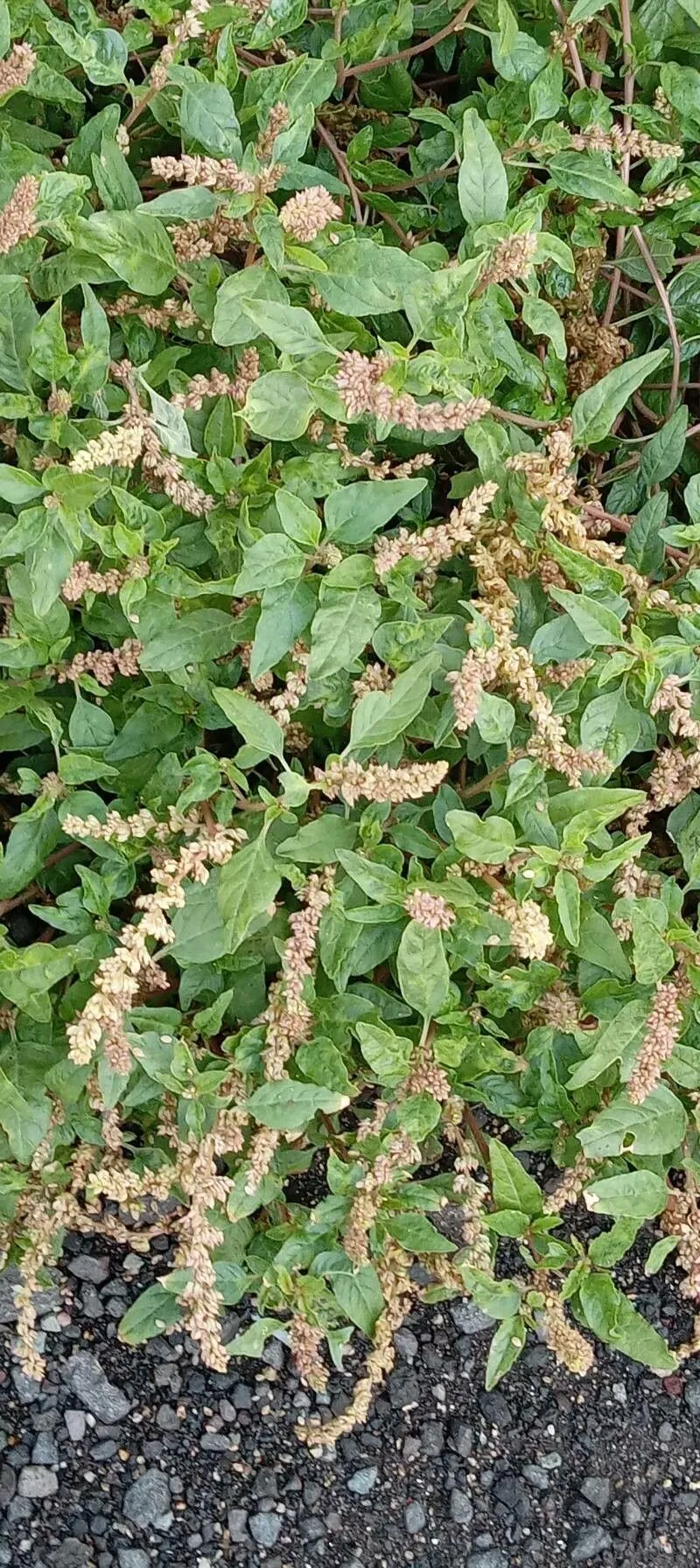
Author: L.
Bibliography: Mant. Pl. 2: 295 (1771)
Year: 1771
Status: accepted
Rank: species
Genus: Amaranthus
Vegetable: Unknown
Observations: Bolivia to S. South America
Argentine amaranth, scientifically known as Amaranthus deflexus, is a noteworthy member of the Amaranthaceae family. Recognized for its adaptability and prevalence, this plant spans a considerable geographic range from Bolivia extending toward Southern South America.
First documented in 1771 in Carl Linnaeus’s renowned work “Mantissa Plantarum,” Argentine amaranth has since captured the interest of botanists and plant enthusiasts alike due to its resilient nature and its role within its ecosystem. This plant exemplifies the dynamic nature of the Amaranthus genus, known for its versatile and often hardy species.
Argentine amaranth typically thrives in a variety of environments, from fertile grounds in agricultural landscapes to less hospitable urban settings, where it often colonizes disturbed soils. Its presence is beneficial in several ways, such as helping to prevent soil erosion with its robust root system and contributing to the nutrient cycle through its organic matter.
In terms of morphology, Argentine amaranth features distinct characteristics typical of the amaranth family. The plant is marked by its green foliage, and it may produce small clusters of inconspicuous flowers. These features, although not necessarily striking in appearance, play essential roles in its reproductive strategy and ecological interactions.
Argentine amaranth also plays a substantial role in traditional practices and modern applications. In various cultures within its native range, it has been used both as a food source and in medicinal remedies. Its seeds are often harvested for their nutritional value, high in proteins and essential amino acids, proving invaluable in regions where food security is a critical concern.
Whether viewed through the lens of botany, ecology, or cultural significance, Argentine amaranth stands out as a plant of considerable interest. It embodies the resilience and utility of the Amaranthaceae family, contributing to both natural habitats and human livelihoods across its extensive range.
Fra: amarante couchée, amarante étalée
Ita: amaranto prostrato
Eng: argentine amaranth, large-fruit amaranth, largefruit amaranth, perennial pigweed, deflexed amaranth, low amaranth, spreading amaranth, tow amaranth
Spa: bledo rastrero, amarant, amaranto, bledo, blet, blet punxent, marxant
Mlt: denb id-dib, ghobbejra
Dan: krybende amarant
Deu: liegender amarant, liegender fuchsschwanz
Heb: yarbuz natuy, ירבוז נטוי
Por: bredo-perene, caruru-rasteiro
Swe: krypamarant
Ces: laskavec skloněný
Ell: polyetes vlito
Hun: vöröslő disznóparéj
Nld: liggende majer
Cym: blodyn amor parhaol
En: Argentine amaranth, Perennial pigweed, Spreading amaranth, Tow amaranth, Deflexed amaranth, Low amaranth, Large-fruit amaranth, Largefruit amaranth, Large-fruited amaranth
Af: Meerjarige misbredie
Ca: Blet corbat, Amarant deflex
Cs: Laskavec skloněný
Da: Krybende amarant
Nl: Liggende majer
Fi: Rikkarevonhäntä
Fr: Amarante couchée, Amarante étalée
De: Liegender Fuchsschwanz, Herabgebogener Amarant, Liegender Amarant, Herabgebogener
El: Polyetes vlito
He: Yarbuz natuy, ירבוז נטוי
Hu: Vöröslő disznóparéj
It: Amaranto prostrato
Mt: Denb id-dib, Ghobbejra
Pt: Caruru-rasteiro, Bredo-perene
Es: Bledo rastrero, Amarant, Amaranto, Bledo, Blet, Blet punxent, Marxant, Amaranto rastrero
Sv: Krypamarant
Cy: Blodyn amor parhaol
© copyright of the Board of Trustees of the Royal Botanic Gardens, Kew.
© copyright of the Board of Trustees of the Royal Botanic Gardens, Kew.
© copyright of the Board of Trustees of the Royal Botanic Gardens, Kew.
Taken Nov 30, 2022 by Fabrice Rubio (cc-by-sa)
Taken Jul 20, 2022 by Fabrice Rubio (cc-by-sa)
Taken Sep 18, 2018 by Llandrich anna (cc-by-sa)
Taken Sep 26, 2022 by Fabrice Rubio (cc-by-sa)
Taken Sep 17, 2022 by Fabrice Rubio (cc-by-sa)
Taken Aug 8, 2021 by Didier EYCHENNE (cc-by-sa)
Taken Nov 2, 2019 by Jeanine Vialatte (cc-by-sa)
Taken Oct 17, 2016 by Tela Botanica − Alain POUZOU (cc-by-sa)
Taken Sep 17, 2022 by Fabrice Rubio (cc-by-sa)
Taken Jan 10, 2022 by Tony Watson (cc-by-sa)
Taken Sep 9, 2020 by Heras Daniel (cc-by-sa)
Taken Sep 9, 2020 by Heras Daniel (cc-by-sa)
Taken Sep 26, 2022 by Fabrice Rubio (cc-by-sa)
Taken Sep 17, 2022 by Fabrice Rubio (cc-by-sa)
Taken Nov 18, 2021 by . Andrea (cc-by-sa)
Taken Sep 7, 2009 by Martin Bishop (cc-by-sa)
Taken Sep 17, 2021 by Carine Siceaux Planche (cc-by-sa)
Taken Aug 29, 2022 by Fabrice Rubio (cc-by-sa)
Taken Sep 26, 2022 by Fabrice Rubio (cc-by-sa)
Taken Dec 3, 2022 by martinezcandela778 (cc-by-sa)
Taken Jul 3, 2022 by Fabrice Rubio (cc-by-sa)
Taken Jun 19, 2022 by Fabrice Rubio (cc-by-sa)
Taken Jul 13, 2022 by Fabrice Rubio (cc-by-sa)
Taken Jul 3, 2022 by Fabrice Rubio (cc-by-sa)
Taken Jul 28, 2021 by Tali Shapiro (cc-by-sa)
Taken Sep 4, 2014 by Tela Botanica − Liliane Roubaudi (cc-by-sa)
Taken Jun 22, 2013 by Tela Botanica − Dominique REMAUD (cc-by-sa)
Taken Dec 20, 2021 by Angel Mesch (cc-by-sa)
Taken Aug 17, 2014 by Tela Botanica − Philippe ROBERT (cc-by-sa)
Taken May 20, 2014 by Tela Botanica − Céline VIDAL (cc-by-sa)
Family: Myrtaceae Author: (F.Muell.) K.D.Hill & L.A.S.Johnson Bibliography: Telopea 6: 402 (1995) Year: 1995 Status:…
Family: Rubiaceae Author: Pierre ex A.Froehner Bibliography: Notizbl. Bot. Gart. Berlin-Dahlem 1: 237 (1897) Year:…
Family: Sapindaceae Author: Koidz. Bibliography: J. Coll. Sci. Imp. Univ. Tokyo 32(1): 38 (1911) Year:…
Family: Asteraceae Author: A.Gray Bibliography: Pacif. Railr. Rep.: 107 (1857) Year: 1857 Status: accepted Rank:…
Family: Fabaceae Author: Medik. Bibliography: Vorles. Churpfälz. Phys.-Ökon. Ges. 2: 398 (1787) Year: 1787 Status:…
Family: Aspleniaceae Author: (Cav.) Alston Bibliography: Bull. Misc. Inform. Kew 1932: 309 (1932) Year: 1932…